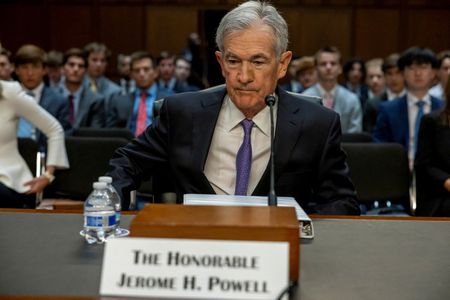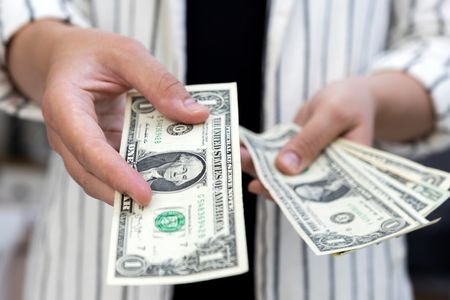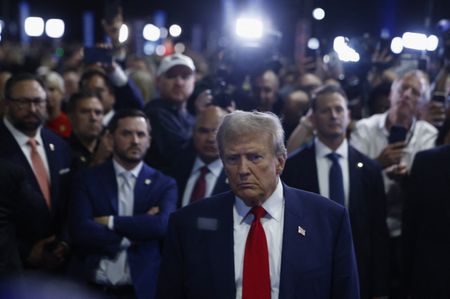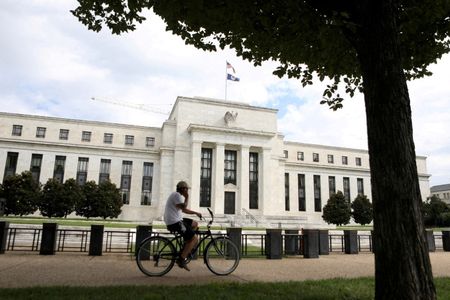By Saqib Iqbal Ahmed and Lewis Krauskopf
NEW YORK (Reuters) -Amazon’s stock split may provide some solace to shareholders who have seen the e-commerce giant’s shares battered this year.
Amazon shares were up 3.1% to $126.17 in afternoon trading after the 20-for-1 split, announced earlier this year but which took effect Monday. They have fallen 24% year-to-date, roughly comparable to the loss in the Nasdaq Composite, as rising interest rates slam risk appetite and pressure shares of high-growth companies.
While a split has no bearing on a company’s fundamentals, it could help buoy its share price by making it easier for a wider range of investors to own the stock, market participants said.
“Stock splits are certainly associated with successful stocks,” said Steve Sosnick, chief strategist at Interactive Brokers. “The psychology remains that stock splits are good. We can debate whether they are or aren’t, but if the market perceives them to be a positive, then they act like a positive.”
Analysts at MKM Partners believe the rally in Amazon shares since May, during which they have cut their year-to-date loss by a third, has been aided by anticipation of the split.
“While we view this event as a largely non-fundamental one, we believe a stock split and potential retail trading activity could provide an incremental catalyst to turn sentiment on AMZN shares,” MKM’s Rohit Kulkarni said in a note on Monday.
Stock splits may drive additional participation from retail investors, who, on average, tend to trade in smaller sizes due to their limited capital, relative to institutional investors, according to a Cboe report published in May.
The effect was most pronounced for stocks with larger market capitalization, according to the report, which analyzed 61 stocks across all market capitalization categories that have split since 2020.
Peng Cheng, head of big data and AI strategies at JPMorgan, said retail investors’ ownership in Amazon’s shares had been comparatively low, compared to robust retail activity in the company’s options – a sign that a four-digit share price may have been turning off individual traders.
“Psychologically, it doesn’t feel good to spend $1,000 and own a third of a share,” he said.
BofA Global Research has found that splits “historically are bullish” for companies that enact them, with their shares marking an average return of 25% one year later versus 9% for the market overall.
Stock splits may increase the pool of investors able to dabble in options, especially for stocks with high dollar value, analysts said.
For instance, on Friday, a trader looking to bet on Amazon shares rising by 12% by July 1 would have had to pay roughly $2,900. On Monday, a bet on the same percentage gain in the shares by July 1 cost about $135, according to Reuters calculations.
Still, options are not quite as big a force in the market as they were last year at the height of the so-called meme-stock mania.
“Had this happened a year ago, when individual traders were enamored with call speculation in a way none of us had seen before, this would have been much more explosive,” Sosnick said.
Of course, a stock split alone is unlikely to overcome the host of other factors that have driven shares lower this year, including worries over tighter monetary policy and decades-high inflation.
At the same time, the rise of commission-free trading and the advent of fractional shares have taken away some of the immediate appeal of stock splits for investors, said Randy Frederick, vice president of trading and derivatives for the Schwab Center for Financial Research.
“It’s not nearly as big a deal as it used to be in the old days,” Frederick said.
Amazon is the latest megacap company to split its stock. Other companies that have split their shares since 2020 include Apple, Tesla and Nvidia.
Alphabet Inc also announced a 20-for-1 stock split in February, with its split expected to take effect next month.
(Reporting by Saqib Iqbal Ahmed and Lewis Krauskopf; Additional reporting by John McCrank; Editing by Ira Iosebashvili and Nick Zieminski)











